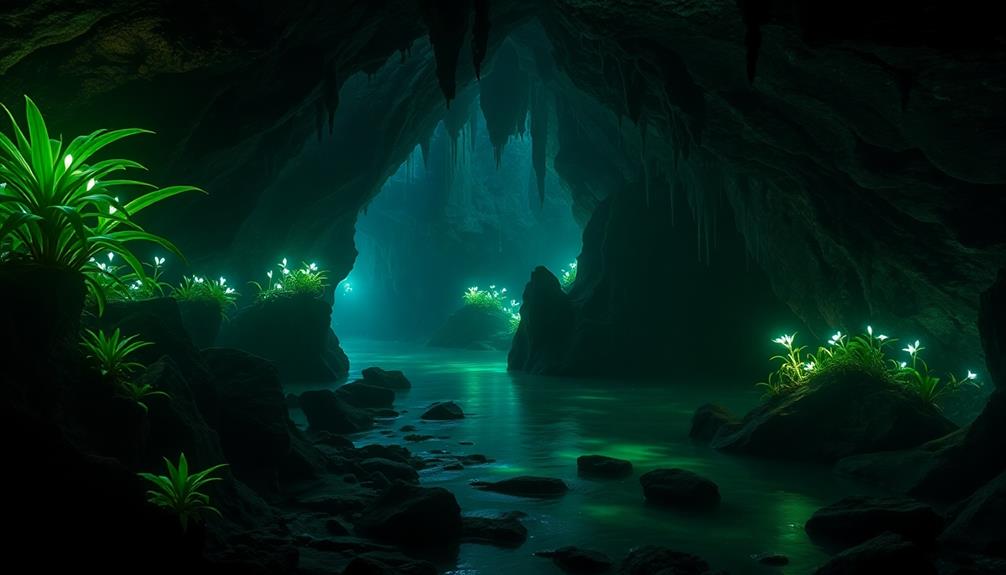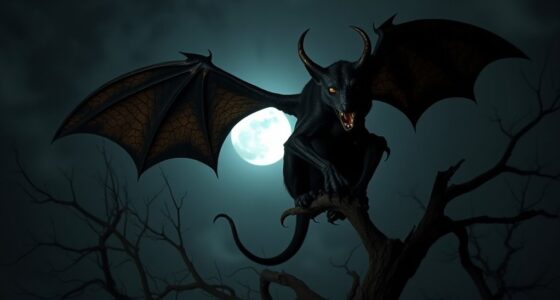If Mothman appears before every major disaster, it's more than just coincidence. Historically, sightings often align with catastrophic events, like the Silver Bridge collapse. This eerie connection heightens community anxiety and reinforces Mothman's reputation as a harbinger of doom. People interpret encounters as ominous warnings, influencing their behavior and mindset. In modern urban areas, reports continue, suggesting Mothman still plays this chilling role. Such sightings spark interest in local folklore and promote disaster preparedness. This peculiar phenomenon intertwines fear and fascination, raising intriguing questions about its significance and impact. There's much more to explore about this enigmatic figure.
Key Takeaways
- Mothman's sightings often coincide with significant disasters, suggesting a pattern of ominous warnings perceived by witnesses before calamities occur.
- Communities may interpret Mothman's appearance as a harbinger of doom, heightening anxiety and prompting increased vigilance among residents.
- Historical context links Mothman to tragic events, reinforcing its role as a cultural symbol of impending disaster and collective fear.
- Modern sightings continue to emerge, particularly before crises, indicating a resurgence of interest and belief in Mothman's predictive nature.
- The lore surrounding Mothman influences societal behavior, as locals may take precautionary measures in anticipation of potential disasters following sightings.
Historical Sightings and Origins
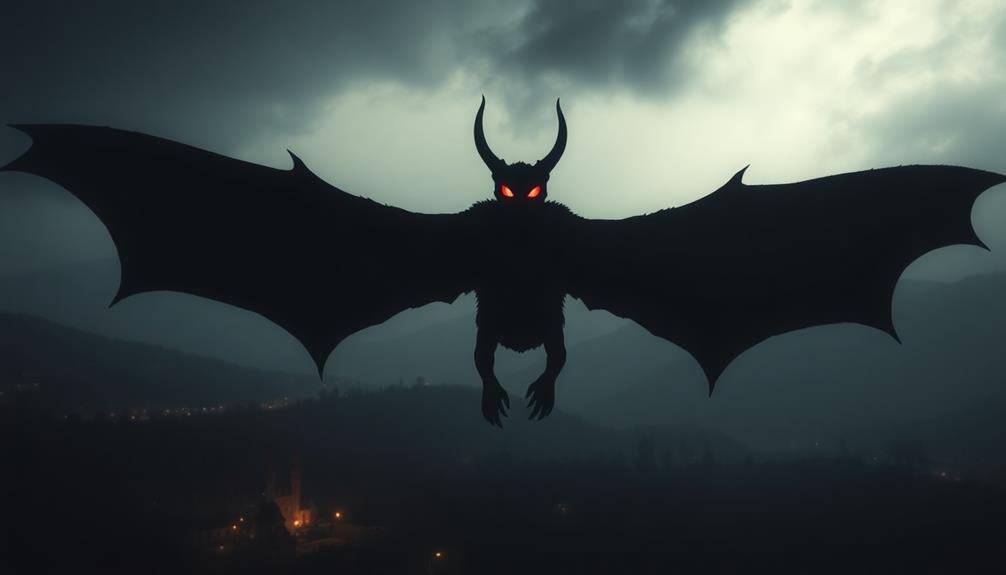
Historically, sightings of Mothman frequently emerged in the mid-1960s, particularly around Point Pleasant, West Virginia. The first reported sighting took place on November 15, 1966, near the TNT area, where witnesses described a large, winged creature with glowing red eyes.
As Mothman sightings increased, residents began to connect these unexplained phenomena to local disasters, creating a chilling narrative. The legend gained notoriety after the tragic Silver Bridge collapse on December 15, 1967, which claimed 46 lives. Many locals claimed to have seen Mothman in the days leading up to this catastrophic event, further entwining the creature with the town's fate.
Over 100 sightings were reported throughout the 1960s, fueled by media coverage that amplified public interest and fear. This growing sense of unease in the community led you and your neighbors to investigate the origins of Mothman, trying to understand its connection to various ominous events.
As time went on, the association between Mothman and disasters persisted, with sightings reported before other tragic occurrences, deepening its reputation as an eerie harbinger of doom.
Mothman as a Harbinger of Doom

You might notice a pattern in Mothman sightings, often appearing just before major disasters, like the Silver Bridge collapse.
This connection raises questions about how such encounters impact society's psyche and create a sense of foreboding.
As you explore these historical sightings, consider how communities interpret this eerie presence and its implications for their collective anxiety.
Historical Sightings Overview
Many people believe that Mothman serves as a harbinger of doom, with its sightings often preceding significant disasters. The legend began in Point Pleasant, where the first sighting occurred on November 15, 1966, just a month before the Silver Bridge collapse, which tragically claimed 46 lives.
Witnesses reported seeing Mothman near the bridge the day before this catastrophic event, which led to speculation about its ominous role.
Over time, residents connected Mothman sightings to various disasters, reinforcing its reputation as an omen. Some notable instances include:
- Silver Bridge Collapse (1967) – The pivotal event that solidified Mothman's association with disaster.
- Chernobyl Disaster (1986) – Sightings were reported shortly before the nuclear tragedy.
- September 11 Attacks (2001) – Witnesses claimed to have seen Mothman in the days leading up to the events.
- Other Local Disasters – Several smaller incidents in the region have also been linked to sightings.
These historical sightings contribute to the ongoing discussion about Mothman's role as a harbinger, leaving many to ponder its significance in predicting disasters.
Psychological Impact on Society
The Mothman legend considerably impacts society by instilling a sense of dread and anxiety among those who believe in its ominous presence. The connection between Mothman sightings and disasters, like the Silver Bridge collapse, heightens community anxiety. You might notice that when reports of Mothman emerge, residents become increasingly vigilant and fearful, attributing impending calamities to this creature.
| Aspect | Impact on Society | Examples |
|---|---|---|
| Sightings | Heightened community anxiety | Reports before disasters |
| Psychological Response | Desire for control over fear | Finding meaning in chaos |
| Mothman Lore | Cultural symbol of doom | Reinforces disaster narratives |
| Media Portrayals | Amplifies fear and anxiety | Documentaries and films |
| Disasters | Creates a collective experience | Shared panic and vigilance |
This collective psychological response offers a way to cope with uncertainty. Instead of facing random misfortune, communities find solace in identifying a supernatural warning sign. As media portrayals further entrench this belief, Mothman becomes more than just folklore; it transforms into a harbinger of doom, affecting societal behavior and perceptions.
Cultural Impact on Local Communities

In Point Pleasant, WV, the Mothman legend has woven itself into the very fabric of the community, transforming it into a vibrant tourist destination. This phenomenon has had a remarkable impact on the local economy and cultural heritage, evidenced by several key developments:
- The Mothman Festival, attracting up to 10,000 visitors annually, considerably boosts tourism and local businesses.
- Local shops thrive on Mothman-themed merchandise, which has become integral to the town's identity.
- The iconic 12-foot-tall Mothman statue, revealed in 2003, not only serves as a popular attraction but also symbolizes the community's embrace of the legend.
- The Mothman Museum, opened in 2005, offers insights into the creature's history and its influence on local folklore, reinforcing its cultural significance.
Residents generally express positive sentiment toward these Mothman-themed attractions. They recognize the economic benefits and social connections that arise from the ongoing fascination with Mothman sightings.
As the legend continues to thrive, it solidifies Point Pleasant's place in pop culture while honoring its unique cultural heritage.
Modern-Day Interpretations and Sightings
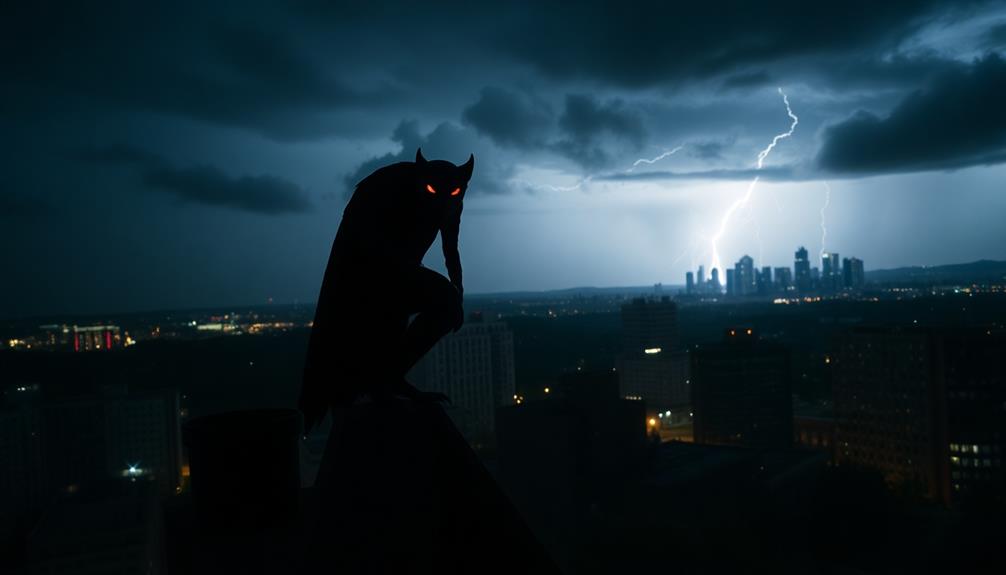
As you explore recent sightings of Mothman-like figures, you'll notice a pattern emerging, particularly in urban areas like Chicago.
These encounters not only echo the original lore but also raise questions about their cultural symbolism and potential implications.
You might find it fascinating how these sightings provoke theories about Mothman's role as an omen in relation to disasters.
Recent Sightings Reports
Recent reports of Mothman-like creatures have surfaced across urban landscapes, particularly in Chicago, where researcher Lon Strickler has documented an astonishing 161 sightings.
These encounters echo the original 1966 sightings in Point Pleasant, with witnesses describing a distinct humanoid figure featuring glowing red eyes and a large wingspan.
The recent sightings suggest intriguing patterns and associations:
- Urban Concentration: Strickler's map indicates a high concentration of sightings in urban areas, hinting at possible migrations or multiple entities rather than just one creature.
- Pre-Disaster Appearances: Some witnesses claim to have seen Mothman shortly before significant disasters, such as the 2016 earthquake in Italy.
- Social Media Influence: The rise of social media has amplified the sharing of recent sightings, reigniting public interest in this cryptid's lore.
- Historical Echoes: Modern descriptions align closely with the features reported decades ago, suggesting a persistent presence.
These factors contribute to a growing fascination with the Mothman phenomenon and its potential connection to disasters, leaving you to wonder what might happen next.
Cultural Symbolism and Impact
Embodying fear and fascination, Mothman has evolved into a powerful cultural symbol, deeply intertwined with modern interpretations of disaster and warning.
Often viewed as a harbinger of doom, Mothman sightings have been reported before major disasters, including the tragic Silver Bridge collapse in 1967. This pattern has solidified Mothman's reputation as an ominous figure, linking it to significant events like the Chernobyl disaster and September 11, 2001.
As a cultural icon, Mothman inspires a mix of fear and curiosity, prompting a resurgence of interest in various media, including documentaries and films.
In Point Pleasant, West Virginia, Mothman-themed attractions, such as the Mothman Museum and the annual Mothman Festival, celebrate this creature's legacy, drawing thousands of tourists and embedding it into the local identity.
Online communities and social media platforms have further amplified discussions and reports of Mothman sightings.
This modern interpretation of the legend positions Mothman not only as a cautionary figure but also as a source of local pride, showcasing how its symbolism resonates deeply within contemporary culture.
Theories on Interpretations
Mothman's mysterious nature continues to enthrall imaginations, especially as modern sightings gain traction in urban areas like Chicago.
With over 161 documented encounters echoing the original sightings in Point Pleasant, people are increasingly intrigued by this phenomenon.
Many interpretations suggest Mothman serves as a harbinger of disaster, leading to varied theories among enthusiasts and skeptics alike.
Here are four prevalent interpretations of Mothman sightings:
- Ominous Warning: Witnesses often believe that sightings precede significant tragedies, viewing Mothman as a warning sign of impending doom.
- Cultural Reflection: Skeptics argue that societal fears and media portrayals shape interpretations of Mothman, suggesting it thrives on cultural narratives rather than objective evidence.
- Psychological Projection: Some theorists posit that people project their anxieties onto Mothman, interpreting its presence as a manifestation of their fears surrounding disasters.
- Cryptid Resurgence: The rise of online communities has revitalized interest in Mothman, leading to new interpretations that blend fear and fascination with the unexplained.
As these theories evolve, Mothman remains a mesmerizing symbol of both dread and intrigue.
Theories and Skepticism Surrounding Mothman

In the wake of numerous reported sightings, theories and skepticism surrounding Mothman have flourished, particularly as they relate to catastrophic events. Many eyewitnesses claim to have seen Mothman before disasters like the Silver Bridge collapse in 1967, which resulted in 46 fatalities. This connection has reinforced the legend of Mothman as an omen of doom.
However, skeptics argue that these sightings could stem from misidentified large birds, such as sandhill cranes or owls, providing a rational explanation for the phenomenon.
Moreover, some researchers suggest that mass hysteria may have played a role in the proliferation of Mothman sightings during the 1960s, fueled by societal fears and anxieties. Investigations into Mothman's glowing red eyes indicate that many reports might be secondhand accounts, raising doubts about the reliability of eyewitness testimony.
Despite these skeptical theories, the enduring legend of Mothman persists, tapping into our deep-seated fears of the unknown. Ultimately, whether you view Mothman as a supernatural harbinger of disaster or a product of misidentification, the debate continues, highlighting the human fascination with the mysterious and the ominous.
Mothman's Influence on Disaster Preparedness
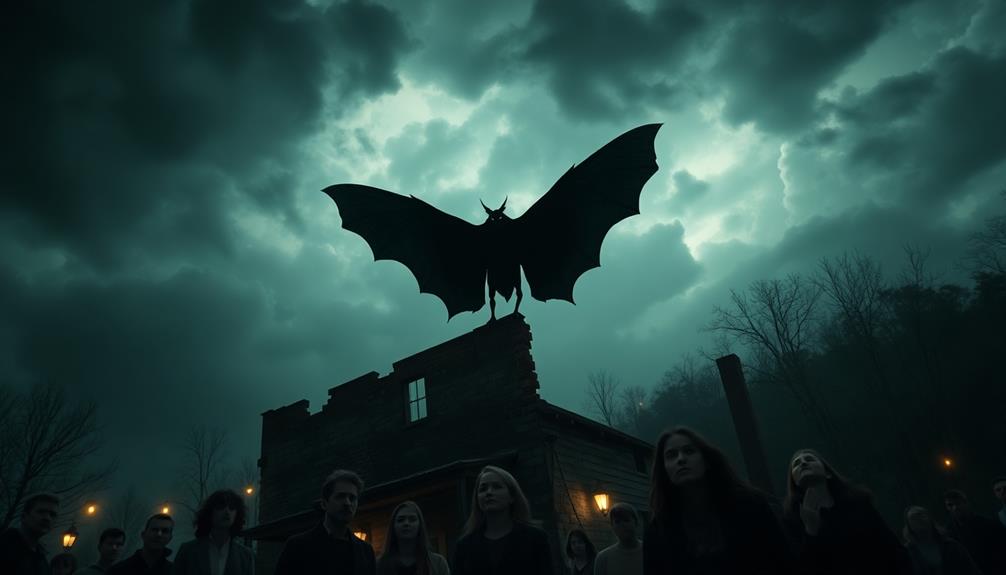
The legend of Mothman, often viewed as a harbinger of disaster, has surprisingly influenced how communities approach disaster preparedness. In Point Pleasant, where sightings have historically preceded significant events, residents have adopted a proactive stance on safety. This has led to enhanced community engagement and a focus on emergency response strategies.
Here are some ways Mothman has impacted disaster preparedness:
- Increased Vigilance: Mothman sightings remind locals to stay alert and recognize potential warning signs.
- Disaster Drills: Communities have initiated regular disaster drills, ensuring everyone knows what to do in emergencies.
- Educational Initiatives: Local organizations promote awareness about resilience and preparedness, using Mothman as a focal point.
- Annual Festivals: Events centered around the Mothman myth serve as platforms for educating residents about emergency response plans.
Through the lens of Mothman, Point Pleasant has transformed fear into a commitment to readiness.
This unique cultural phenomenon not only keeps the legend alive but also strengthens the community's ability to face unforeseen challenges with confidence and preparedness.
Conclusion
In the end, whether you believe in Mothman or not, his shadow looms large over our understanding of disaster. As we navigate life's uncertainties, it's hard to ignore the tales that paint him as a harbinger of doom. Maybe he's just a figment of imagination, or perhaps a warning to keep us on our toes. Either way, when the chips are down, it's wise to heed the signs—because you never know when the next storm might hit.


